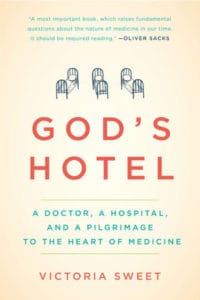
Dr. Victoria Sweet is the author of God’s Hotel: A Doctor, a Hospital, and a Pilgrimage to the Heart of Medicine (Riverhead Books, 2012). She is a woman deeply influenced by Hildegard von Bingen, the medieval saint who the Pope recently named a Doctor of the Church for her teaching of theology and practice of natural science and music.
In God’s Hotel, Sweet writes about her experience of working at San Francisco’s Laguna Honda Hospital, the last almshouse in the country, a rare vestige of the Hôtel-Dieu that cared for the sick in Europe in the Middle Ages.
From the book’s website:
Ballet dancers and rock musicians, professors and thieves — “anyone who had fallen, or, often, leapt, onto hard times” and needed extended medical care — ended up there. Dr. Sweet ended up there herself, as a physician. And though she came for only a two-month stay, she remained for 20 years.
At Laguna Honda, lower-tech but human-paced, Dr. Sweet had the chance to practice a kind of “slow medicine” that has almost vanished. Gradually, the place and its patients transformed the way she understood the body. Alongside the modern view of the body as a machine to be fixed, her patients evoked an older notion, of the body as a garden to be tended. God’s Hotel tells their stories, and the story of the hospital, which — as efficiency experts, politicians, and architects descended, determined to turn it into a modern “health care facility” — revealed its truths about the cost and value of caring for body and soul.
I caught up with her during her book tour to ask her a few questions. Here’s just a snippet of our delightful conversation.
What is one early misconception you had while working at Laguna Honda, and how did you grow out of it?
Victoria Sweet: One early misconception I had at the hospital was that I’d gotten there “accidentally.”
What happened was that I had decided to go back to school to study Hildegard of Bingen’s medicine, and Laguna Honda Hospital in San Francisco was the only place that would let me practice medicine part-time.

It took years for that misconception to change. But bit my bit, I began to see that the old-fashioned hospital, with its Romanesque exterior, its 1920s interior, and its kind staff, was the perfect place for me to be. Originally it had been the San Francisco Almshouse, which was how we used to take care of the sick poor, and it was directly descended from the medieval monastic infirmaries where Hildegard practiced her kind of medicine. I learned—through practice—the three principles it had to teach, which were the old principles of the almshouse, the monastery, and Hildegard—hospitality, community, and charity. I don’t think I could have understood them so clearly had I been practicing medicine any where else. Eventually I saw that it wasn’t accident that brought me there, but serendipity.
In the book you talk about how removed Laguna Honda was from the mainstream medical system. “No one paid any attention to us,” you write. “And that, for a doctor, is a wonderful thing.” It appears that the very thing that gave you freedom to do with your patients as you saw fit was also what made the patients so vulnerable in the first place—they were poor, unwanted, problems that the regular system was only too happy to throw in your direction. Can you comment on this? Doesn’t that kind of freedom for doctors make patients particularly vulnerable to bad doctors? In other words, how can we balance freedom with accountability?
VS: A complex question. The freedom we had as doctors at Laguna Honda had more to do with the physical hospital itself—tucked away over the hill to the poorhouse, out of sight and out of mind—than it did with the poverty of the patients. Now that the New Laguna Honda is so spiffy, so modern, and so visible, the very same patients and doctors are subjected to an almost paralyzing accountability, with every stroke of the keyboard monitored and every pill accounted for. The only other group of patients who get the kind of doctoring that the poor patients of the old Laguna Honda used to get are the rich, those who can afford to privately employ a personal doctor and allow him or her to do as he or she sees fit.
But that doesn’t answer your fundamental question about freedom and accountability, about how we prevent poor patients from being vulnerable to bad doctors. I don’t think poor patients are any more or less vulnerable than other patients to bad doctors. We’re all vulnerable to bad doctors.
In the case of Laguna Honda the freedom I write about in God’s Hotel was only a relative freedom. There were many checks and balances on us. For instance, other doctors reviewed what we did; pharmacists kept track of which medications were ordered; and a bad or unexpected outcome—a transfer to the acute hospital, a death, a deterioration—was always investigated. But it wasn’t a paralyzing accountability, because the basic assumption was that the doctors were trying to do their best for their patients.
Twenty years from now, which of your patients will you remember the most?
VS: So many! But the patient I would want to remember most would be Terry Becker. She was 37 years old when I first met her, a prostitute who lived on the streets with her abusive boyfriend, Mike. She came to the hospital after she became paralyzed by an unusual disease called transverse myelitis. For about a year and a half she went back and forth between the streets, the County Hospital, and Laguna Honda Hospital, until she developed the largest bedsore I’d ever seen. It went from the middle of her back to the base of her spine, and it was so deep that I could see her spine. It was inoperable and untreatable, and I thought Terry would die.
But she didn’t die. That bedsore healed, very slowly, over two and half years, and watching it heal changed the way I practiced medicine. I saw how it filled in, week by week, healing from outside in and from inside out, until Terry’s back just had a fine pink scar on it. It seemed almost magical, and it was what premodern medicine called the “Healing Power of Nature”—what Hildegard called its “greening power” (viriditas)—the innate power of the body to fix itself.
So, after Terry, in addition to doing everything modern that I could think of to help a patient improve—all the modern tests, x-rays, and treatments—I also thought about how I could fortify my patients’ own natural healing power with good food, rest, minimum medications, and enough time to heal. I call that Slow Medicine, as opposed to the Fast Medicine I also use.
 If you could sit down and chat with Hildegard von Bingen today, what would you ask her?
If you could sit down and chat with Hildegard von Bingen today, what would you ask her?
VS: I’ve often asked myself that. Hildegard was a complex person—an inspired visionary; a composer of haunting Gregorian chants; a down-to-earth medical practitioner; a confident, even bossy, leader of her own monastery—and I still can’t fathom, even after all these years of studying her, how all her parts fit together, or whether we would even like one another.
And what language would we use? I know that isn’t quite what you mean, but, really. Her languages were medieval German and medieval Latin; they provided her her concepts and her basis for understanding her world. Where would we start to have a conversation? What would she think of us?
She would be appalled and shocked by our world, is what she would think of us. At first. But, eventually, she would understand it. Because it isn’t so different from her own—its violence and wars, its power struggles and politics; its forests, birds, and clouds. So perhaps that is what we would chat about, and I would ask her how she would manage in it; how she would balance quietude with action; interior with exterior; activity with meditation, Martha and Mary.


